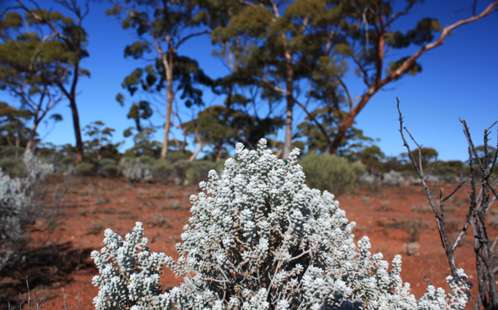Research shows future heat waves a threat to Australia's plant life

It may not feel like it in Australia right now, but over the past year we've experienced the hottest global temperatures on instrumental record. This could spell bad news for Australia's plants.
A study, published in the journal Global Change Biology (opens in new window), has found that across much of inland Australia plants are near a tipping point in their ability to cope with rising high-temperature extremes. This suggests that future heat-waves could have devastating effects on Australia's flora.
"We surveyed plant life around the globe for their high-temperature tolerance," said Professor Owen Atkin of the ARC Centre of Excellence in Plant Energy Biology (opens in new window) at the Australian National University, who led the study.
"We show that, while heat tolerance is higher in plants near the equator than in the arctic, the potential for damage is most severe for hot, inland, mid-latitude regions. Here, maximum air temperatures during heat-waves are most extreme".
"Plants growing in the dry, inner regions of Australia are at particularly high risk. We could see dramatic changes to the face of Aussie plant life in the future".
The international team of researchers looked at plants from habitats all over the world, including nineteen remote sites in the arctic, tropics and deserts. The study is the most comprehensive analysis of heat tolerance in plants to date.
By exposing leaves to increasing temperatures during controlled tests, the researchers were able to pinpoint the exact temperatures where leaf metabolism becomes damaged by heat. They found that two critical processes for plant growth and survival, namely photosynthesis and leaf respiration, were damaged by high-temperature extremes.
"The study suggests high temperatures during heat waves will damage a plant's ability to function, particularly in sun-exposed, upper canopy leaves" said lead author Dr Odhran O'Sullivan.
"This means extreme heat-wave events, predicted to increase in intensity with climate change, could have devastating effects on natural plant populations and ecosystems, and the latitudes at risk will likely expand in the long term".
Co-author Professor Mark Tjoelker of the Hawkesbury Institute for the Environment at Western Sydney University said "the potential for high-temperature heat-damage is greatest during periods of drought, when plants are unable to use water to naturally cool leaves".
The findings of the study also have important implications for farmers growing crops in hot, inland regions of Australia.
"We know that crop yields are negatively affected by heat-waves, often when crops are flowering. Our results point towards heat damage to leaves being a further factor contributing to reduced crop yields. The potential for such damage will only increase as global temperatures rise" said Prof. Atkin.
"Because heat-waves are becoming more extreme and frequent, there is an urgent need to improve heat tolerance of leaf metabolism in crops, such as wheat, that are often grown in hot, arid regions."
More information: Odhran S. O'Sullivan et al. Thermal limits of leaf metabolism across biomes, Global Change Biology (2016). DOI: 10.1111/gcb.13477
Journal information: Global Change Biology
Provided by University of Western Sydney


















